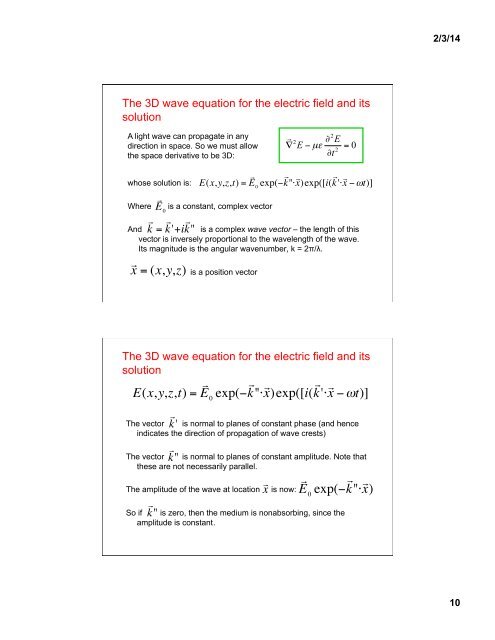What is a wave? The one-dimensional wave equation
What is a wave? The one-dimensional wave equation
What is a wave? The one-dimensional wave equation
Create successful ePaper yourself
Turn your PDF publications into a flip-book with our unique Google optimized e-Paper software.
2/3/14<strong>The</strong> 3D <strong>wave</strong> <strong>equation</strong> for the electric field and itssolutionA light <strong>wave</strong> can propagate in anydirection in space. So we must allowthe space derivative to be 3D:€€whose solution <strong>is</strong>: WhereAndE 0k = €E(x,y,z,t) = E 0exp(− k "⋅ x )exp([i( k '⋅ x − ωt)]<strong>is</strong> a constant, complex vectork '+ik "<strong>is</strong> a complex <strong>wave</strong> vector – the length of th<strong>is</strong>vector <strong>is</strong> inversely proportional to the <strong>wave</strong>length of the <strong>wave</strong>.Its magnitude <strong>is</strong> the angular <strong>wave</strong>number, k = 2π/λ.x = (x,y,z)<strong>is</strong> a position vector€€€<strong>The</strong> 3D <strong>wave</strong> <strong>equation</strong> for the electric field and itssolution€E(x,y,z,t) = E 0exp(− k "⋅ x )exp([i( k '⋅ x − ωt)]<strong>The</strong> vector <strong>is</strong> normal to planes of constant phase (and henceindicates the direction of propagation of <strong>wave</strong> crests) k "<strong>The</strong> vector <strong>is</strong> normal to planes of constant amplitude. Note thatthese are not necessarily parallel. €k '<strong>The</strong> amplitude of the <strong>wave</strong> at locationk "<strong>is</strong> now:So if <strong>is</strong> zero, then the medium <strong>is</strong> nonabsorbing, since theamplitude <strong>is</strong> constant . €€xE 0exp(−k "⋅x )10
















